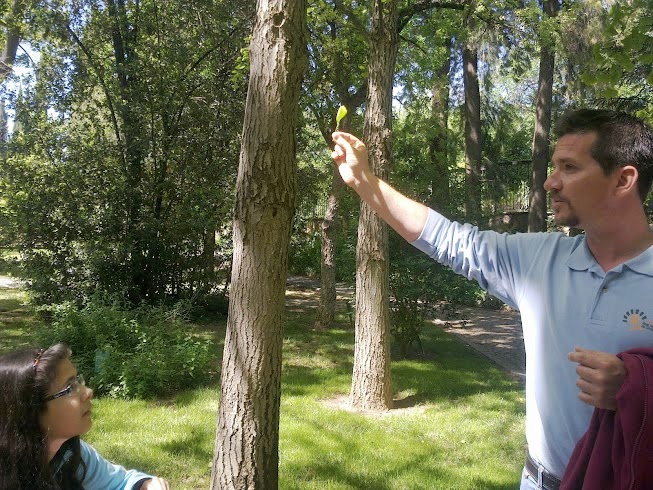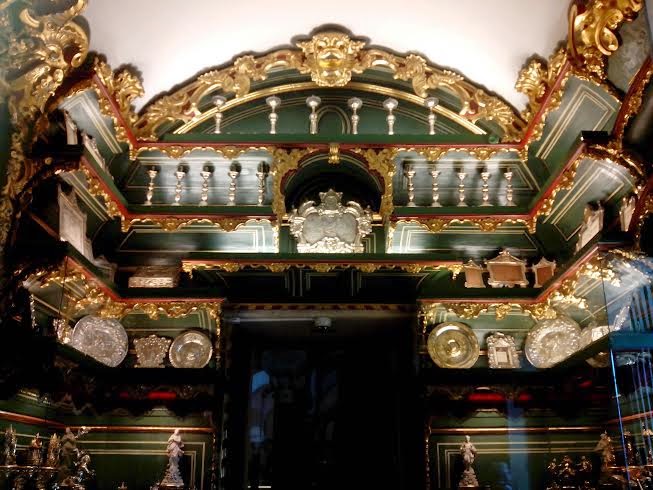Last April 25th we went on a field trip to Cordoba. Based on the individual reports handed in by the students who went on this trip, we have prepared a report in English on how it went that we hope will be useful to others who will have to prepare reports on field trips in the future.
We would like to thank Jesús Rodrigo, Elena Delgado and Belén Madrid for the photos that illustrate this post. Everyone took a lot of pictures and some used them to illustrate their individual reports beautifully, but these three students took the trouble to send Booknosey/Fisgalibros copies of their pictures. Thanks, kids! As for the photos of inteviewed tourists, we did our best to scan them from individual reports, which explains why they are a little hazy.
OUR TRIP TO CORDOBA
I – ON THE ROAD TO CORDOBA:
Getting there was half the fun!
Getting there was half the fun!
Time of departure for Cordoba: 7:45 a.m. on a fine
April day.
Means of Transportation: A big coach or bus.
Who we were: We were 52 students from 1st, 2nd and 3rd year bilingual classes and the three teachers that teach bilingual groups: Antonio (Social Studies and Ethics), Victoria (Science, Physics and Chemistry) and Salomé (English).
Who we were: We were 52 students from 1st, 2nd and 3rd year bilingual classes and the three teachers that teach bilingual groups: Antonio (Social Studies and Ethics), Victoria (Science, Physics and Chemistry) and Salomé (English).
What we did on the bus: Talk, play, listen to music.
Who we sat with: We sat with our friends and some of us made new ones.
Raphael, who is very serious, sat with the teachers and conversed with them on
highly knowledgeable subjects.
Where we stopped on the way: Halfway to Cordoba we
stopped at a service area with a restaurant that also had a souvenir shop. Belén
M. and Ángela C. got the name of the place we stopped at right. It was called
Los Abades and it was in Bailén.
Time of arrival in Cordoba: We arrived at 11:OO a.m.,
the trip takes three hours. The bus left us near the botanical gardens.
II – THE BOTANICAL GARDENS:
Where are they? In front of the zoo, in the Avenida
Linneo (Linneus Avenue).
Who received us there? Two guides, Barbara and Frank
(Paco or Fran).
Frank took charge of the 1st year students and
Barbara took charge of 2nd and 3rd year students. Barbara
was a pleasant lady in her late twenties who told Eros she would never forget
him because he was a bit annoying and Frank was, according to Ainhoa C., tall,
thin and friendly.
What we saw there: Lots of plants and plant fossils. The
guides said the gardens had three main areas: educational, gardening and
fossils. There were different collections of plants. We saw a collection of prehistoric
plants called living fossils that can still be found living. We saw another collection of plants that are typical of the Canary Islands inside a greenhouse
with the right temperature for them, because the weather in Cordoba doesn´t
allow them to grow outside.
We saw an
orchard, full of edible fruits and vegetables, like pumpkins, tomatoes, onions,
nectarines, etc.
We also saw many strange plants and trees, like this huge oriental weeping willow.
We saw beds of lovely flowers.
We learned how aloes
are used to help heal people´s skin and how you can make jelly with them too. We learned you can eat marigolds in salads.
And we learned you can make lavender icecream.
There was a
gingko biloba tree, which is very medicinal, and there was a sequoia as old as
one of our older classmates but enormously tall. Its roots ran underground all the way to
the river we could see from the gardens.
One day it will be enormous, because
it is one of the oldest and biggest trees on earth. Mario D. and Israel N. say
they learned it is from the west of America and can live 2000 to 3000 years and
grow over a hundred meters.
We also entered
a building full of fossils of plants. The best thing on display was an
imitation of a huge fossil found in our very own community, La Mancha, a type
of fern from Puertollano (portollanense onflayosollos).
That above is the tip of this fossil. The reproduction was made of silicone and the plant was at least
two meters tall.
Mario D. and Israel N. also
like the holes made by insects in some of the fossils found near a volcano.
They
also liked the tree trunks converted into solid rocks.
Outside, they saw plants that could resist high temperatures and drought. Some had
no leaves so as not to lose water. They do photosynthesis from the trunk.
We also saw expositions of plant life in different
environments, rain forests, Mediterranean woods, etc.
Did we like the botanical gardens? Do we recommend
visiting them? Yes, we liked them and we recommend visiting them. Everyone
should see them.
How long did the visit last? At what time did it end?
The visit lasted about an hour and a half. It ended at one o´clock p.m..
III –LUNCH:
Where did we have lunch? Some of us had lunch in the
botanical gardens. We sat on benches in shady nooks and ate the food we brought
with us. Others waited till we got to the Mosque in the city tourist center.
What did we have for lunch? We brought sandwiches and
chips and fruit and cookies and sweets with us. Drinks, too, mostly pop or
water. These were a little hot. Raphael
says he had chocolate for lunch. Was it melted? Luis F. says he had a tenderloin
sandwich and a coke in the Orange Courtyard, and he didn´t have enough time to
have lunch comfortably.
Did we have enough time to have lunch comfortably?
Some of us did. Others say they didn´t.
IV – INTERVIEWING TOURISTS:
Where and when did we do this? Outside the Cathedral /Mosque
of Cordoba.
Where the tourists nice? Did they cooperate? Most of
the tourists were very nice. They answered all our questions and asked us some.
Some even had their pictures taken with us.
These were the questions we asked the tourists and
these were their answers:
1. Why did you come to Cordoba? About 65% of the
tourists said they had come specifically to visit the city. Most of the rest
were touring Andalusia. A few were there because they were doing the Camino de
Santiago, that is, they were pilgrims making their way to St. James in Galicia.
Long way to go!
2. How long will you be here? 79% said they would only
be there for a day.
3. Do you like the food here? 100% answered yes to
this question and said they loved the tapas. 42% said they loved the salmorejo.
30% loved the Spanish potato omelet and 20% mentioned they liked the fried
fish.
4. Would you recommend visiting Cordoba to other
people? 100% said that yes, they would.
Last, we thanked the tourists who cooperated for their
help and wished them a nice stay in Spain.
V – THE CATHEDRAL AND MOSQUE:
What time did we get there? At two o´clock p.m.
Who received us? Nobody did. Our teachers went to
speak with the people in charge of admittance. They had already reserved a time
for us to see the place that day.
Did we have human guides? We were each given a
headphone and our teacher Antonio spoke to us through it and gave us a very
complete lecture on the Mosque, covering its history and art.
Did the headphones work? Yes. We were able to hear
Antonio very clearly.
Did we behave well there? It is a place of worship, so
we had been told to be very quiet and respectful and we were. Some of us got a
little nervous towards the end of our visit, but all went well.
Description of the Mosque and Cathedral, inside and
outside: Outside was the orange tree patio.
It was lovely,with beautiful trees
with oranges and fountains. Many people were sitting there enjoying the sight.
Inside, the best thing was the endless array of red and white arches. We saw
different kinds of arches, vaults and doors, typical mosque lamps.
We also saw Christian side altars and a
wonderful main altar.
We also saw the treasure rooms, where all kinds of
precious religious objects are kept. We saw tombs on the ground and paintings
on the roofs, and we saw organs and the place where the choir sings.
What did we learn here? Many things about the culture
of Christians, Visigoths and Muslims and about Art and History. Mariano said he
learned about construction and architecture. Alicia and Carmen María noticed
that the name of the cathedral is Our Lady of the Assumption, Holy Mother of
God and that it is a World Heritage Site.
VI – EXTRAS:
We also saw: the Swamp Fresneda, the river
Guadalquivir, the fair grounds where they were setting up the May Fair, which
started many years ago as a livestock sale.
We saw the bridge of St. Raphael too and a statue of him. St. Raphael is the guardian angel of the city of Cordoba.
We learned about watermills. We have windmills in La Mancha.
We listened to a lady who played the violin very nicely. Some of gave her some coins,
Marina G. noticed the
horse-drawn carriages and thought they were lovely. She would have liked to
ride in one. So romantic.Pity we haven´t got a picture of one,
VII – RETURN TRIP
At what time did we leave Cordoba? At 6:15 p.m.
How was the return trip? Jesús, Santiago and José
Miguel said it was “very good!” Although we were tired, we were a little
noisier on our way back than on our way there. Mariano acted up a bit and some
of us got scolded. But nothing serious.
Did we stop anywhere? We stopped at the same place
where we had on our way to Cordoba. We were at this shop and restaurant for
about half an hour. Some people bought souvenirs and other stuff. Sara bought a
kit-kat and a frame with her mum´s name, Virginia a Super-pop magazine, etc.
At what time did we arrive at our school? At 9:15 p.m.
VIII –
CONCLUSION:
Did we enjoy our trip? Yes, we all had fun.
The best and the worst of it: The following are some
opinions of some students who went on this trip. Jesús, Santiago and José Miguel
said the best was all and the worst was nothing. Laura L. and Alicia M. said
they had to repeat this trip. Marina M. and Laura A. said that the best of it
was the landscape and the worst was that the ride was very long. Ángela C. and
Belén M. thought the trip was long too, and what they liked best was
interviewing the tourists. Marina P. loved interviewing the tourists but was a
little bored by the long lecture at the mosque. Virginia and Sara thought the
best thing was the Cathedral –Mosque because it was lovely and the worst thing
the heat. Elena D. thought the trip was a lot of fun, being with her friends
and loved the Catherdral Mosque. Zaira Llaneza liked the whole trip. Daniel
G.M. enjoyed this activity and wants to do more activities in English.




































